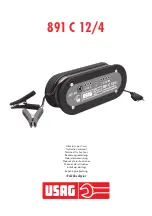
6
Important Safety Instructions
7. WARNING – RISK OF EXPLOSIVE GASES.
a) WORKING IN THE VICINITY OF A LEAD-ACID BATTERY IS DANGEROUS. BATTERIES GENERATE
EXPLOSIVE GASES DURING NORMAL BATTERY OPERATION. FOR THIS REASON, IT IS OF
UTMOST IMPORTANCE THAT EACH TIME BEFORE USING YOUR CHARGER, YOU READ THIS
MANUAL AND FOLLOW THE INSTRUCTIONS EXACTLY.
b) To reduce risk of battery explosion, follow these instructions and those published by battery
manufacturer and manufacturer of any equipment you intend to use in vicinity of a battery(s).
Review cautionary markings on these products.
8. PERSONAL PRECAUTIONS
a) Someone should be within the range of your voice or close enough to come to your aid
when working near a Lead-acid battery.
b) Have plenty of soap and water nearby in case battery acid comes in contact with skin,
clothes or eyes.
c) Wear complete eye protection and clothing protection. Avoid touching eyes while working
near battery(s).
d) If battery acid contacts skin or clothing, wash immediately with soap and water. If acid
enters eye, immediately flood eye with running cold water for at least 10 minutes and get
medical attention immediately.
e) NEVER smoke or allow a spark or flame in the vicinity of a battery or engine.
CAUTION
- To reduce the risk of injury, charge only the battery types shown on
the ProNauticP user interface label i.e. Lead-acid type rechargeable batteries (Flooded,
Sealed Flooded, GEL (Gelled Electrolyte Lead-acid) or AGM (Absorbed Glass Mat)). Other
types of batteries may burst, causing personal injury. The ProNauticP is factory set for
Sealed Flooded (Lead-acid) batteries.
f) Incorrect assembly may result in electrical shock or fire.
g) Be extra cautious to reduce risk of dropping a metal tool onto a battery, it might spark or
short-circuit the battery or other electrical hardware that may cause a fire or explosion.
h) Remove all personal metal items such as rings, bracelets, necklaces, watches and
jewelry when working near a battery. A battery can produce a short circuit current high
enough to weld a ring or any other metal, causing serious burns.
i) Do not use the battery charger to charge dry cell batteries that are commonly used with
home appliances i.e. a cordless power drill battery. These batteries may burst and cause
injury to persons and damage to property.
j) NEVER charge a frozen battery.
9. PERSONAL SAFETY WHILE PREPARING TO CHARGE BATTERIES ON-BOARD
OR OFF-BOARD
a) If necessary to remove a battery(s) from a boat to charge, always remove the
negative (-) grounded terminal from battery first. Make sure all accessories in the boat
are off, so as not to cause an arc.








































